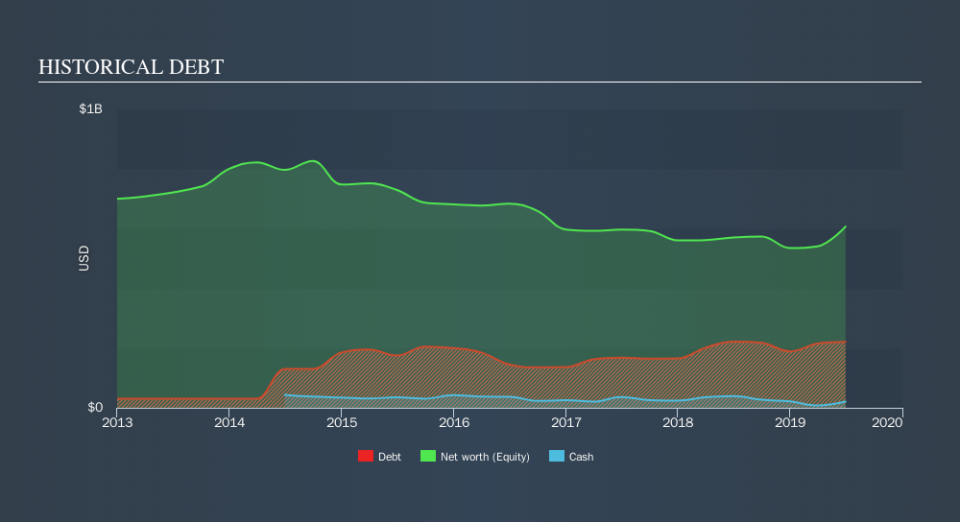Is TimkenSteel (NYSE:TMST) Weighed On By Its Debt Load?

The external fund manager backed by Berkshire Hathaway's Charlie Munger, Li Lu, makes no bones about it when he says 'The biggest investment risk is not the volatility of prices, but whether you will suffer a permanent loss of capital. It's only natural to consider a company's balance sheet when you examine how risky it is, since debt is often involved when a business collapses. We note that TimkenSteel Corporation (NYSE:TMST) does have debt on its balance sheet. But should shareholders be worried about its use of debt?
Why Does Debt Bring Risk?
Debt assists a business until the business has trouble paying it off, either with new capital or with free cash flow. Part and parcel of capitalism is the process of 'creative destruction' where failed businesses are mercilessly liquidated by their bankers. However, a more frequent (but still costly) occurrence is where a company must issue shares at bargain-basement prices, permanently diluting shareholders, just to shore up its balance sheet. Of course, plenty of companies use debt to fund growth, without any negative consequences. The first step when considering a company's debt levels is to consider its cash and debt together.
See our latest analysis for TimkenSteel
How Much Debt Does TimkenSteel Carry?
The chart below, which you can click on for greater detail, shows that TimkenSteel had US$221.3m in debt in June 2019; about the same as the year before. On the flip side, it has US$20.9m in cash leading to net debt of about US$200.4m.
How Healthy Is TimkenSteel's Balance Sheet?
We can see from the most recent balance sheet that TimkenSteel had liabilities of US$155.0m falling due within a year, and liabilities of US$417.3m due beyond that. Offsetting this, it had US$20.9m in cash and US$146.4m in receivables that were due within 12 months. So it has liabilities totalling US$405.0m more than its cash and near-term receivables, combined.
The deficiency here weighs heavily on the US$268.9m company itself, as if a child were struggling under the weight of an enormous back-pack full of books, his sports gear, and a trumpet." So we'd watch its balance sheet closely, without a doubt After all, TimkenSteel would likely require a major re-capitalisation if it had to pay its creditors today. When analysing debt levels, the balance sheet is the obvious place to start. But ultimately the future profitability of the business will decide if TimkenSteel can strengthen its balance sheet over time. So if you're focused on the future you can check out this free report showing analyst profit forecasts.
In the last year TimkenSteel wasn't profitable at an EBIT level, but managed to grow its revenue by3.3%, to US$1.5b. That rate of growth is a bit slow for our taste, but it takes all types to make a world.
Caveat Emptor
Importantly, TimkenSteel had negative earnings before interest and tax (EBIT), over the last year. Indeed, it lost US$12m at the EBIT level. When we look at that alongside the significant liabilities, we're not particularly confident about the company. We'd want to see some strong near-term improvements before getting too interested in the stock. Not least because it burned through US$12m in negative free cash flow over the last year. That means it's on the risky side of things. When I consider a company to be a bit risky, I think it is responsible to check out whether insiders have been reporting any share sales. Luckily, you can click here ito see our graphic depicting TimkenSteel insider transactions.
At the end of the day, it's often better to focus on companies that are free from net debt. You can access our special list of such companies (all with a track record of profit growth). It's free.
We aim to bring you long-term focused research analysis driven by fundamental data. Note that our analysis may not factor in the latest price-sensitive company announcements or qualitative material.
If you spot an error that warrants correction, please contact the editor at editorial-team@simplywallst.com. This article by Simply Wall St is general in nature. It does not constitute a recommendation to buy or sell any stock, and does not take account of your objectives, or your financial situation. Simply Wall St has no position in the stocks mentioned. Thank you for reading.

 Yahoo Finance
Yahoo Finance 
